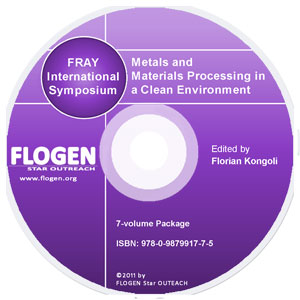
CD shopping page |
2011-Sustainable Industrial Processing Summit
|
| Editors: | Florian K |
| Publisher: | Flogen Star OUTREACH |
| Publication Year: | 2012 |
| Pages: | 708 pages |
| ISBN: | 978-0-9879917-1-3 |
| ISSN: | 2291-1227 (Metals and Materials Processing in a Clean Environment Series) |
Role Of Nanocrystalline Structure In Oxidation Resistance
Raman Singh1; B V Mahesh2; Carl C Koch3;1MONASH UNIVERSITY, Monash Univ (Melbourne), Austria; 2MONASH UNIVERSITY, Monash University, Australia; 3NORTH CAROLINA STATE UNIVERSITY, Raleigh, United States;
Type of Paper: Regular
Id Paper: 127
Topic: 5
Abstract:
The last decade has witnessed a great surge in the materials science and engineering research on the development of nanocrystalline and sub-microcrystalline materials. A great deal of these studies has focused on the fundamental characterisation of the structures and their bearing on the physical and mechanical properties of nano-size and ultrafine grain materials. However, oxidation and aqueous corrosion behaviour of nanocrystalline materials has received very limited research attention. Rather simplistic approach to understanding the role of nanostructure in corrosion as compared to the microcrystalline material of same composition may suggest an increase in corrosion rate of the nanostructured material due to large fraction of grain boundaries (i.e., high energy areas). However, the nature of influence of nanostructure per se on corrosion does not seem to be similar in all cases. In fact, the nature of such influence can be contradictory, depending on the type of corrosion and environment-material system. For example, nanocrystalline structure is reported to improve the resistance of an iron aluminide system in a corrosive gas, whereas the dissolution rate of a nanocrystalline copper is reported to be greater than the conventional polycrystalline copper.This presentation will first develop an overall understanding of the role of grain size in oxidation of Fe-Cr microcrystalline alloys. Then the paper will examine the validity of the mechanistic role of such nanocrystalline grain size oxidation. Examples of authors own work on both micro- and nanocrystalline materials will be presents. In particular, it will show results to establish that an Fe-Cr nanocrystalline alloy with only much less Cr can provide as much oxidation resistance as an Fe-20Cr alloy, suggesting possibility of Fe-Cr alloys with the necessary corrosion resistance at much lower Cr contents. The presentation will also report the role of additives such as zirconium in improving both processing and oxidation resiatnce.